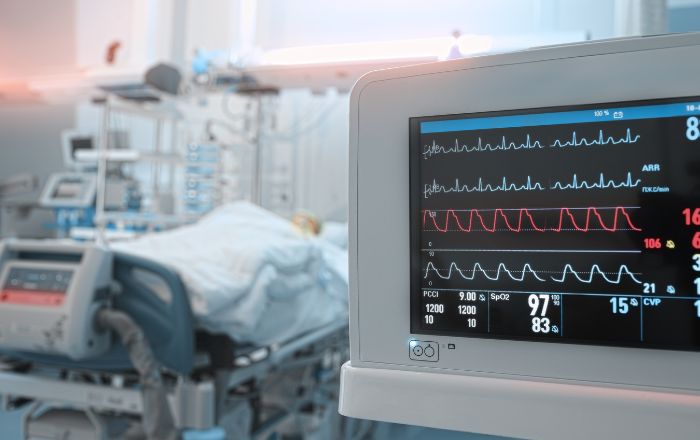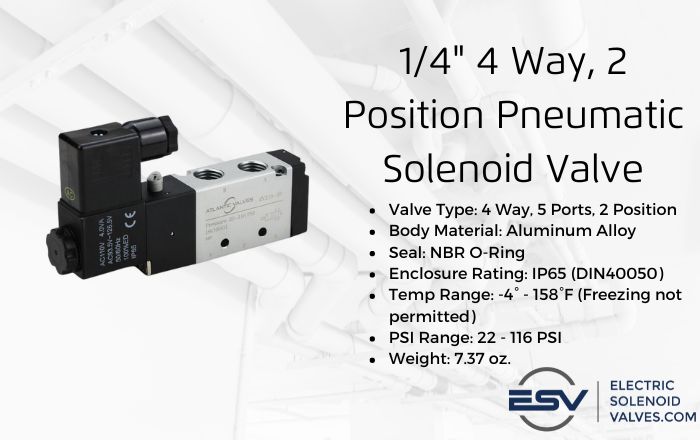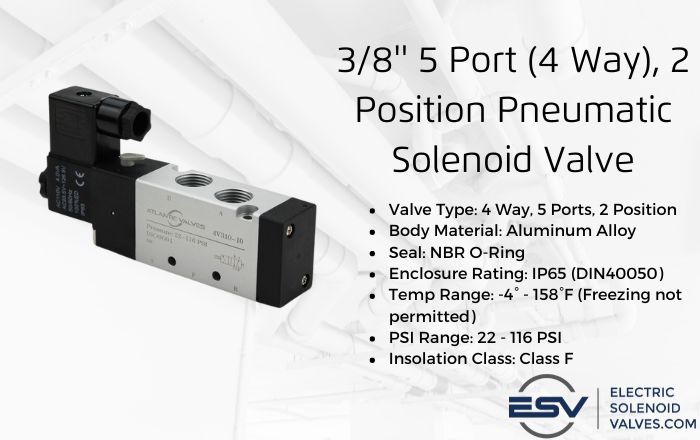Jun 18th 2024
The Role of Pneumatic Solenoid Valves in Medical and Pharmaceutical Applications
Medical devices and pharmaceutical processes rely on air and gasses for various tasks, providing vital patient care and management. Precise and timely regulation of air and gasses is crucial in these applications. Even a small error in controlling the flow can be catastrophic. Patients may not receive the necessary support, and pharmaceutical products may fail to meet quality and safety standards. Specialized valves like pneumatic solenoid valves are essential for accurate air and gas flow control.
About Pneumatic Solenoid Valves
A pneumatic solenoid valve handles gaseous media. They are electromechanical devices whose opening and closing are controlled by a solenoid . When electrical current passes through the solenoid, it creates a magnetic field. This causes the plunger inside of the valve to move and change the valve's positions. The movement of the plunger opens or closes the ports of the valves, allowing or stopping the flow of gasses in the system. Pneumatic solenoid valves have return mechanisms, allowing the plunger to return to its initial position when an electric current is missing.
1/4" 4 Way, 2 position pneumatic solenoid valve
Unlike standard industry valves, pneumatic solenoid valves intended for medical and pneumatic applications must comply with multiple standards and regulations. These valves should demonstrate conformity to standards like ISO 13485, ISO 14644, and ISO 10993 and regional regulations like FDA compliance standards or the European Union Medical Device Regulations (MDR) . These standards ensure that pneumatic solenoid valves are safe for medical devices and the production of various pharmaceuticals without endangering patients and meeting the tight valve safety and reliability requirements.
Aside from meeting industry standards, pneumatic solenoid valves for medical and pharmaceutical applications are subject to additional design and manufacturing considerations. These are:
- Their material selection process must guarantee the biocompatibility of manufacturing materials throughout the valve's lifetime.
- Valve materials should be compatible with the sterilization media. The valves should retain their functionality despite the repeated stress when sterilizing medical devices or pharmaceutical production lines by autoclaving or Gamma radiation sterilization.
- Dependable leak tightness and accurate flow control.
Pneumatic Solenoid Valves in Medical Applications
Pneumatic solenoid valves are essential for the performance of various medical devices. The valves directly affect the reliability, safety, and response of medical devices. They are integral to the operation of:
- Respiratory devices
- Patient monitoring systems
- Diagnostic equipment
Respiratory Devices

Solenoid valves are used in ventilators, Continuous airway pressure (CPAP), Bilevel positive air pressure (BiPAP) machines and anesthesia machines. Some functions of pneumatic solenoid valves in these systems are:
- Regulate oxygen delivery in ventilators . The valve controls the quantity and pressure of oxygen delivered to the patient depending on their breathing support needs.
- Control the volume and timing of air delivery to the patient . The pneumatic solenoid valve ensures the oxygen from the ventilator is delivered timely, ensuring patients under medication maintain proper respiration. The valves prevent any possibility of delayed oxygen delivery, which might interfere with the respiratory functioning of the patients.
- They act as a safety feature in anesthesia machines and ventilators . The valves will promptly shut off to prevent cases of over-pressurization, an emergency event that can jeopardize patient safety.
- Maintain consistent air pressure levels in BiPAP and CPAP machines , keeping the airways of patients with sleep apnea open when asleep.
- Change airflow in CPAP and BiPAP machines based on the prevailing breathing patterns of sleeping patients under medication.
Patient Monitoring Systems

Patient monitoring systems record patient conditions in real-time. The monitoring systems capture vast amounts of data to help healthcare workers provide timely medical interventions for enhanced patient care and recovery. Some monitoring systems that use pneumatic solenoid valves include blood pressure monitors, anesthesia gas pressure systems and respiratory monitors. The roles of pneumatic solenoid valves in these systems include:
- Inflate and deflate the blood pressure cuff . The pneumatic solenoid valve ensures the blood pressure monitor precisely measures the patient's blood pressure conditions. The valve controls air pressure and flow rate, ensuring proper cuff inflation and deflation.
- Regulate and measure airflow rates of respiratory gasses by patients in respiratory monitors. The flow rate data helps monitor patient breathing conditions at different stages of medication.
- Sampling gasses in anesthesia machines . The pneumatic solenoid valves regulate the flow of anesthetic gasses to specialized medical sensors that monitor anesthesia gas concentration levels. This regulation of anesthesia gasses is necessary to ensure patients receive the correct dosage.
Diagnostic Equipment

Diagnostic medical devices are vital for identifying illnesses and making accurate treatment decisions. Diagnostic machines have evolved with technology, with most devices using air to run critical components. Some diagnostic machines that require pneumatic solenoid valves to control air and gasses needed for their operation include MRI and CT scanners, endoscopy machines and blood analyzers. The pneumatic solenoid valves perform multiple functions including:
- Regulate the flow of coolant gasses in MRI and CT scan machines . They ensure coolant gasses flow at the required volumes and rates, keeping the scanners operational at optimal temperatures. Maintaining the operations of the scanners at optimal temperature is essential for ensuring the scanners deliver accurate scans and imaging results.
- Pneumatic solenoid valves control the amount of air flowing into endoscopic medical devices . The valve ensures the gasses in the endoscopy machine are sufficient to allow it to enter into body cavities without causing tissue damage or physical harm, allowing medical practitioners to gain a better view of internal organs.
Pneumatic Solenoid Valves in Pharmaceutical Applications
Pharmaceutical applications handle various fluids necessary for producing medicines and disposable medical supplies. These pharmaceutical systems, with varying complexities, rely on multiple valves, each regulating fluid flow at different production stages. Pneumatic solenoid valves serve the following functions in pharmaceutical applications:
- Automating manufacturing systems
- Handling fluid flow for pharmaceutical manufacturing processes
- Pneumatic solenoid valves for quality control
Automating pharmaceutical manufacturing systems
Pneumatic solenoid valves provide a means to automate pharmaceutical manufacturing processes. They play key roles in:
- Regulating Airflow in Automated Systems:
- Ensuring repeatable and accurate operations for filling and packaging pharmaceutical products.
- Facilitating sequential manufacturing processes to maintain consistent product quality.
- Supporting Robotic Systems:
- Controlling air supply at specific flow rates and intervals to enable precise movements of actuators in robotic systems.
- Managing operations such as sorting, labeling, and packaging with high precision.
- Implementing Safety Mechanisms:
- Acting as quick shut-off mechanisms to prevent contamination or accidents when production conditions deviate from standards.
- Ensuring a safe and sterile production environment.
Handling Fluid Flow for Pharmaceutical Manufacturing Processes
The precise handling of fluids is crucial for producing high-quality pharmaceutical products. Pneumatic solenoid valves contribute to:
Mixing and Dispensing Operations:
- Regulating the flow of gasses required for mixing ingredients accurately.
- Ensuring correct dosages are dispensed for consistent product quality.
Cleaning-In-Place (CIP) Processes:
- Controlling the flow of cleaning and sterilizing agents during equipment cleaning.
- Guaranteeing thorough and consistent cleaning to maintain a contaminant-free production environment.
Maintaining Pressure Balance:
- Regulating system pressure to ensure smooth operation of fluid transfer lines.
- Balancing pressure to prevent disruptions and ensure the integrity of production processes.
1/8'' 3 Way, 2 Position Pneumatic Solenoid Valve
Quality Control
Pneumatic solenoid valves are essential for maintaining the high standards required in pharmaceutical production. They ensure:
- Automated Sampling for Quality Checks:
- Continuously extracting process gasses for quality analysis.
- Providing data to detect inconsistencies and implement corrective measures.
- Instrument Calibration:
- Permitting the flow of gasses at predefined volumes, pressures, and temperatures.
- Facilitating accurate calibration of instruments to ensure precise measurements.
- Leak Detection Systems:
- Integral to systems ensuring sterility and preventing leaks.
- Monitoring and maintaining air quality in cleanrooms and controlled environments.
- Air Conditioning in Controlled Environments :
- Regulating the flow of refrigerants in air conditioning systems.
- Controlling airflow to maintain safe temperatures and humidity levels for production and storage.
Why Choose Pneumatic Solenoid Valves from Us
ElectricSolenoidValves.com stocks a wide range of high-quality pneumatic solenoid valves relevant to medical and pharmaceutical applications. These valves have several advantages to ensure medical devices and processes are safe and reliable. Safe healthcare practices and medical production practices constitute better patient care. With our pneumatic solenoid valves, you enjoy versatility, energy efficiency and durability.
3/8'' 5 Port (4 Way), 2 Position Pneumatic Solenoid Valve
Versatility
Our high-quality pneumatic solenoid valves can handle different gasses and are available in multiple constructions. The diverse valve constructions facilitate different functionalities, which include flow control, gas mixing and distribution. The valves are also adaptable to various categories of medical devices and auxiliary equipment like air compressors and gas storage tanks.
Our range of products ensures you have a pneumatic solenoid valve for various pressure and temperature ratings. Customers can customize these valves for diverse applications ranging from gaseous control in a small laboratory to complex fluid handling in a manufacturing facility.
Pneumatic solenoid valves are modular and easy to integrate with existing automation systems. It means medical devices and pharmaceutical manufacturing facilities can undergo upgrades or repairs without demanding extensive redesigns.
Energy efficiency
Pneumatic solenoid valves have excellent energy-saving capabilities. Their operation is intermittent, meaning they draw power when switching only. The solenoid is also designed to operate with the least amount of energy. The energy-saving capabilities of these devices mean medical devices and pharmaceutical applications can perform their duties using low-energy resources and achieve their intended purposes.
Pneumatic valves open and close precisely. The valves optimize the consumption of compressed air and service fluids, ensuring waste control and mitigation. They also have quick response times, implying they distribute just the right amount of air or gasses whenever required.
These types of control valves are efficient and generate the least amount of heat. It implies no additional measures are required to cool the valves during operation, further strengthening the energy efficiency of the fluid control systems.
Durability
Pneumatic solenoid valves feature robust constructions made from various high-quality materials. The high-grade materials can withstand a wide range of temperatures and pressures. The valves have few internally moving parts, a feature that ensures longer operating life and reduces the need for repairs.
The dependable durability of these valves means they can provide safe air and gas service required for medical devices and pharmaceutical applications for the long term.
Conclusion
Pneumatic solenoid valves are indispensable when automating air and gas flow in medical and pharmaceutical applications. These versatile valves can perform various flow control functions while guaranteeing precision, safety and optimal efficiency for high-quality patient care and pharmaceutical products.
Always consult a valve specialist when selecting pneumatic solenoid valves for medical and pharmaceutical applications. Our experts at Electric Solenoid Valves will work you through the intricacies of pneumatic solenoid valves for highly demanding applications and assist you in choosing suitable options from our wide range of valve products.




